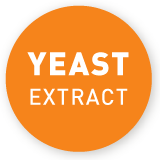Natural glutamic acid
Glutamic acid is one of the twenty natural amino acids which occur in almost every living cell, from microorganisms to plants, animals, and humans. It is the most abundant amino acid in nature. Our body also produces glutamic acid, regardless of the food we consume, as it is naturally present in saliva and breast milk. Many foods that are part of a varied and balanced diet have high glutamic acid content, which guarantees the aromatic taste of numerous recipes. “Glutamic acid is a completely natural building block of proteins”, explains Prof. Dr. rer. nat. Ursula Bordewick-Dell of the University of Applied Sciences Munster. “It is found in all protein-rich food sources – for instance in meat, fish and even in pulses. Glutamic acid is formed naturally through the enzymatic ripening process in food and sometimes in appreciable amounts, for instance in Parmesan cheese. Glutamic acid is therefore a key component in our daily diet – however, many consumers are unaware that it occurs naturally.”
A comparison of amino acid profiles
Like many vegetables, meats and dairy products, yeast extract contains natural glutamic acid, a natural amino acid. Glutamic acid is found in every food, but it naturally occurs in higher concentrations in some food, such as tomatoes, cheese, cured ham, soy sauce and many others. The following diagram uses the examples of tomato paste, Parmesan cheese, pure beef stock cubes and yeast extract paste to show the presence of different amino acids in the respective food.
Two facts become very clear:
- Firstly, glutamic acid is only one of many other natural amino acids that occur in our food.
- Secondly, the content of glutamic acid in yeast extract paste is comparable with the content in tomato paste and in a beef stock cube – the clear leader is matured Parmesan cheese.
Free and bound glutamic acid – what is behind all this?
Glutamic acid occurs in food in two different forms:
- In bound form – Here the glutamic acid is linked with other amino acids and so is therefore bound in proteins. In this form, glutamic acid has only very little taste.
- In free form in plant and animal tissues – This version is the one that makes the taste seem especially aromatic. Food with a high proportion of glutamic acid such as cheese and ripe tomatoes enjoy a high consumer acceptance because of their intensive taste. The proportion of free glutamic acid in plant or animal-based food increases during cooking, fermentation or ripening processes.
Many food cultures have established preparing dishes with the free form of glutamic acid. Examples for this range from the traditional fermentation of soy sauce over the cooking of a meat stock to the maturing of a Spanish Serrano ham. Yeast extract also contains free forms of glutamic acids.
The following examples demonstrate just how many foods and dishes contain a relatively high proportion of free glutamic acid:
| Food item | Available natural glutamic acid (mg/100g) |
|---|---|
| Chicken | 22 |
| Emmental cheese | 308 |
| Parmesan cheese | 4600 |
| Tomato | 246 |
| Tomato paste | 2000 |
| Green peas | 106 |
| Mushrooms | 42 |
| Bouillon containing yeast extract | 40 |
Difference between glutamic acid and monosodium glutamate
Glutamic acid is one of many amino acids in yeast extract. It occurs in all protein-rich and many ripe foods, and is an inherent part of our daily diet. In yeast extract we normally find 5 percent of glutamic acid. This is not to be confused with the flavour enhancer monosodium glutamate (MSG), which is an isolated pure substance of 100 percent sodium salt of glutamic acid, and according to EU food law ranks among flavour enhancers and additives. MSG does not have a characteristic taste or aroma of its own, but is merely added to supplement, enhance, or modify the original taste and/or aroma of a food.
Natural ingredients like tomatoes, cheese, soy sauce or yeast extract have a much broader taste of their own and are labelled as the ingredient itself, such as “tomato powder”, “cheese powder” or “yeast extract”.




